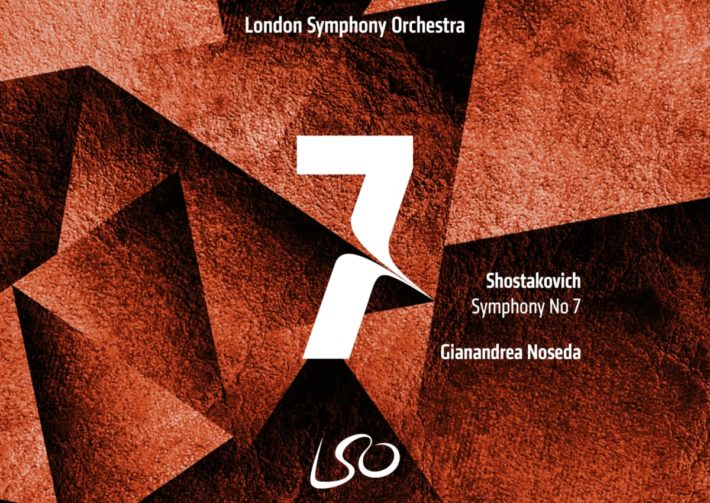The conductor Gianandrea Noseda and the London Symphony Orchestra (LSO) continue their cycle of Dmitri Shostakovich’s symphonies with the wartime No. 7 (“Leningrad”). This is perhaps the only truly egalitarian heroic symphony, and the only one of the heroic genre to command, at once, both pathos and hopefulness. Indeed, in spite of its familiar historical context, Shostakovich intended the symphony to be neither a grand militaristic fanfare nor a symphonic requiem, but a celebration of the beauty of the world and of peace, things for his fellow citizens to hope for again after defeating the Nazis. Shostakovich paints many images, faces, and voices throughout the symphony that are difficult to capture authentically.
The first thing that caught my attention was the speed of the allegretto. Noseda has found the ideal mean here, neither rushing it at the swiftness of Celibidache, Ančerl, Rozhdestensky, or Jansons nor interpreting it as temperately as Toscanini, Bernstein, or Haitink. Noseda’s decision here has several positive effects: the first theme gains the necessary punch and menace at this moderate pace while the brief respites from it manage to retain appropriate amounts of anxious anticipation and uneasy introspection.
Noseda also executes expert judgment in maintaining appropriate dynamic variation throughout the symphony, but a particular moment caught my ear when the snare-drum ostinato moves from a faint, distant threat to a forward advance in the climax of this movement (beginning ca. track 1, 10’51”). Given the dynamic markings, this is the correct approach. The snare drum too frequently becomes dynamically stagnated against the swell of the orchestra in performances that I have heard.
The second and third movements are also of tempos that take a more moderate approach when compared to other popular interpretations, and again to a benefit. The strings appropriately imbue these movements with deep emotion, and the woodwind soliloquies of the second movement work elegantly to inspire empathy and a certain amount of romance in the listener.
Related Posts
- Review: Shostakovich – Symphonies 1, 14 & 15 – Boston Symphony Orchestra, Nelsons
- Review: Shostakovich – Symphony No. 13 (“Babi Yar”) – Russian National Orchestra – Karabits
- Review: Shostakovich – Symphony No. 11 – BBC Philharmonic – Storgårds
Noseda’s reading of the final movement seems to face a hermeneutical problem. The presentation is markedly slow and insinuates an air of despondency. Shostakovich envisioned the finale as a “victory” movement, but this reading sees it as possessing a “grim, warning nature” (so writes David Nice in the program notes). In spite of the evidently futile debates regarding the composer’s allegedly “deeper,” more subversive meanings, Shostakovich’s official position regarding this movement was that it was to portray victory and hope for the future (in accordance with the principles of Soviet Realism). While a whirlwind interpretation like Toscanini’s remains too glib to be effectual, Noseda’s tempos in the final movement elicit the emotional realm of earlier movements rather than that of the finale.
On a first listen, I was admittedly somewhat put off by the comparably less full sound of Noseda’s orchestra against the recent recording of Nelsons conducting Boston. After savoring the album several times, I have decided that the result might be less full but is not empty and, importantly, no less compelling than more grandiose recordings. In fact, there is something in this more intimate approach that frequently yields deeper engagement with the many elements of this long symphony.
Nevertheless, the brasses leave much to be desired in a roundness that has come to be expected in this piece, and can feel hollow in those moments when one expects a full attack. However, there might be an interpretative advantage in this seemingly less forward presentation: If, at times, the brass feels stifled by competition with the rest of the orchestra, the effect stands to benefit the intended portrait of the resolute people of Leningrad preparing against their approaching enemy. This would only be effective in the first movement and end of the finale though. Yet, even with this theory in hand, old habits are hard to break, and old tastes more so, and my own ear prefers the more robust sounding brass sections under Nelsons (Boston) and Bernstein (Chicago) in this singular regard.
In the end, this recording stands quite apart from others on the market, but perhaps for the better. Noseda has managed to question several presumptions about this monumental symphony in ways that are deserving of close listening and further reflection.

Shotakovich – Symphony No. 7
London Symphony Orchestra
Gianandrea Noseda – Conductor
LSO Live, CD LSO0859
Recommended Comparisons
Read more classical music reviews or visit The Classic Review Amazon store
Follow Us and Comment:
Get our periodic classical music newsletter with our recent reviews, news and beginners guides.
We respect your privacy.








